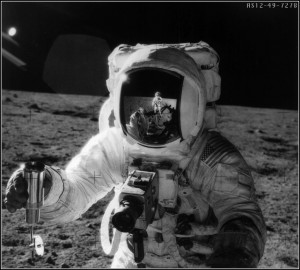The Super Moon series
 Back a few weeks ago many of my friends were excited by TV reports of a “Super Moon” – the moon at perigee (it’s closest orbital point to the earth).
Back a few weeks ago many of my friends were excited by TV reports of a “Super Moon” – the moon at perigee (it’s closest orbital point to the earth).
But as they set up cameras to record shots of this slightly-larger-than-normal celestial phenomenon, I found myself reflecting on my childhood, and upon my lifelong relationship with the moon.
Born in 1953, space was the place through my entire childhood, and from the time I was 10, we as a nation were in the business of going to the moon. In many ways, I am a child of the moon as much as one of the ’60s.
I watched every launch of every American manned space mission from Alan Shepard’s sub-orbital Mercury flight to Apollo 17 when we left our final bootprints in the lunar soil.
 As a boy I used to lie on my back on the lawn of our upstate New York home on warm summer nights, staring up at the moon and dreaming of one day walking on its surface. As a junior in high school I watched the grainy black and white images as Neil Armstrong and Buzz Aldrin climbed down the ladder of their lunar module and loped along the surface, picking up rocks and setting up instruments before planting a flag and heading back inside to return to the earth.
As a boy I used to lie on my back on the lawn of our upstate New York home on warm summer nights, staring up at the moon and dreaming of one day walking on its surface. As a junior in high school I watched the grainy black and white images as Neil Armstrong and Buzz Aldrin climbed down the ladder of their lunar module and loped along the surface, picking up rocks and setting up instruments before planting a flag and heading back inside to return to the earth.
I came to the University of Arizona in 1971 – just a year before that last landing – to study with the men who were assisting the Apollo astronauts in what I assumed was just the beginning of lunar exploration. It was during that last moon landing that the news was broken to me that we would probably never travel to the moon again in my lifetime. That was a stunning realization. I had always seen myself as being part of that second generation who would build telescopes on the moon and make geological studies of its topography, rocks and soil. It was absolutely life changing.
A professor suggested I take anything I was interested in and find another path, since going to the moon had been my sole focus since early boyhood. So I took art and music classes, radio and television and a variety of other unrelated courses to see if something else might stick. And music did. I spent years working in record stores, writing about music and composing works of my own.
 So as my friends sat on hills around Tucson, Arizona trying to get the best shot of that jumbo moon over the cactus, I found myself back in my studio remembering footage of those loping figures on the lunar surface, and of the moon peaking through clouds and shimmering in the warm night air. I spent the next few nights writing music to reflect those images and the nostalgic place the moon has had in my life. These simple pieces in many ways are among the loveliest and most complete musical statements of my career as a composer.
So as my friends sat on hills around Tucson, Arizona trying to get the best shot of that jumbo moon over the cactus, I found myself back in my studio remembering footage of those loping figures on the lunar surface, and of the moon peaking through clouds and shimmering in the warm night air. I spent the next few nights writing music to reflect those images and the nostalgic place the moon has had in my life. These simple pieces in many ways are among the loveliest and most complete musical statements of my career as a composer.
Here are a few examples of the music inspired by the moon as seen from earth and by the men who walked its rocky face.
• Super Moon 1 – Movement 1 of the Super Moon series, scored for solo instruments (electric piano in this case)and FabFilter effects. Composed by Daniel Buckley. Copyright 2013, Saguaro Furnace Music, all rights reserved.
• Super Moon 2 – Scored for guitar and FabFilter creative effects (Volcano and Timeless 2). Composed by Daniel Buckley, Copyright 2013, Saguaro Furnace Music, all rights reserved.
• Super Moon 5 – Work for 8Dio Wrenchenspiel and FabFilter effects. Composed by Daniel Buckley. Copyright 2013, Saguaro Furnace Music, all rights reserved.
